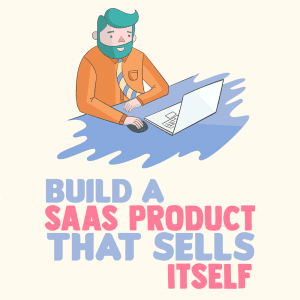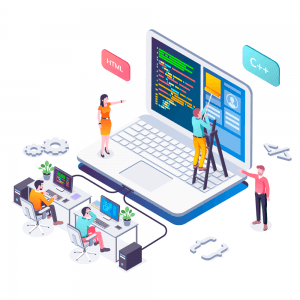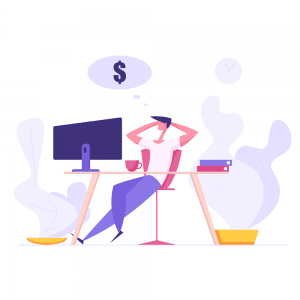Build a SAAS Product That Sells Itself
As an up-and-coming software as a service (SaaS) programmer, you face some challenges, the first being how you hope to turn a profit when all is said and done.
If you wish to build a SaaS product that is so good it virtually sells itself, you need to know the end right from the beginning.

That means understanding your audience and building a product that solves their specific needs. As a programmer, there are several areas on which you must focus, but defining your audience is the first step.
Define Your Audience
Before you start, you need to identify your audience. Too many SaaS programmers get bogged down early on trying to cater to multiple audiences.
Furthermore, the number of SaaS products on the market right now can leave you empty-handed if your content doesn’t add any additional value to the user.
If you begin development with a clear picture of your ideal user in mind, you can create an insightful product without overcomplicating the dashboard.
The best way you can understand your ideal audience is by thinking of your SaaS application less like a product and more like a solution. People who turn to your product will have an issue for which they need a solution, even if they don’t clearly understand what that is yet.
If you clearly define what problem you’re solving, you can better know your audience. Knowing who your audience is and what they need will ultimately allow you to create a user journey that will be satisfying, helping you deliver a product of great value.
Focus on Your MVP
Building a SaaS product should involve a completely different process than the ones you use on other applications because there should be more strategy involved throughout the entire project. Once you identify your audience, define what you need for a minimum viable product (MVP).
If your eye drifts off into other areas, it’s easy for your product to become overly complicated and bloated to an epic scale.
This clutter issue can happen as you or your client might start getting excited about the product, and begin running in all different directions. It is crucial that you keep your eye on your MVP.
By focusing on an MVP, you will eliminate waste and get the product to market sooner, which is where the real feedback loop begins. The sooner users can tell or show you how they use the product, the higher the odds of success.
Know the Language
No matter the application, a SaaS product requires two sides of development: the client side and the server side. To properly develop both sides, there are various programming languages that you can use for your SaaS App development.
- PHP – PHP is an HTML-embedded scripting language that is very easy to understand. If you choose PHP, you will be able to write dynamically generated pages quickly.
- Node.js – Node.js uses an event-driven, nonblocking I/O model that makes it lightweight and perfect for data-intensive real-time applications that run across multiple devices. Another benefit of using Node.js is that it enables you to write both the front-end code and the back-end code in the same language.
- Python – Python is one of the best styles for performing data analysis. It is also suitable for dynamic typing, metaprogramming, and rapid prototyping. Python is an excellent choice for new programmers due to its clean syntax and use of whitespace.
- Java – Java is a widely used programming language in the corporate world. While it might run slower and require more memory, it is an excellent choice for a variety of platforms.
- C# – This programming language is an excellent choice for apps developed through Microsoft.
Unless you are using Node.js, you will need to know how to write using two languages: one language that runs on the browser side, and one that runs on the server side.
For example, you can develop your server side in Python and the client side in HTML/CSS with JavaScript for interaction. The choice of your server-side language is not as important, but you should pick the style where you are most comfortable.
Front End Goes First

Once you know which languages you are using, start with the front end. By beginning on the front end of development, you will see where functionality fits into the user experience.
That user experience is crucial to your product’s success. You will also gain thoughtful insights into what works and what doesn’t before you go too deep into the programming process.
By starting on the front end, you can avoid some otherwise costly mistakes such as writing too much code or shoehorning elements on the front side that make the platform look cluttered or disorganized. Plus, you’ll get a clear idea of where to go next to make your SaaS more appealing to buyers.
Think About Integration
Another critical aspect of SaaS sales involves how your software product will integrate with other applications so that you maximize product value and streamline an integration process.
Start by deciding which services you want to integrate with or might be of value to your customer. These integrations should include inbound and outbound services and tools.
Choose integrations that provide value to your user, differentiate your product on the market, and gain exposure. Don’t worry about finding every combination possible, only those that are most crucial to your application.
Once you get to the market, you can see which ones worked best and test new ones as you go.
Look at Each Feature
As you get deeper into programming, take time to look at what you have created. Look at each feature you have included and whether it is part of the original MVP.
Additional features are great but tend to take time away from being on the market, where you can test whether the product is attractive to users.
These feedback loops between the market and you will push you toward creating more mindful features in the future.
Also, building a full-scale platform could be a waste of your resources. You could spend time and money looking into a feature that is useless to your audience.
Looking at each element compared to your application’s core function, you can identify ways to simplify your product and get to market sooner.
Consider Sales Tools
Most programmers don’t worry about sales until their application is ready to launch. If you want to be a step ahead of the game, you should develop a set of sales tools that will make your product stand out on the market.
Through nearly a decade of experience with enterprise, mid market, and startup companies in the technology market, Launch Leads, a B2B lead-generating service, found that coupling SaaS technology with strategic sales features can significantly increase buyer interest.
When developing any new SaaS product, you should strongly consider adding the following to your application:
Easy-to-Follow User Tutorials
If your application takes a little bit of time for the user to fully grasp, including user tutorials can help users and potential customers to better understand the value of your product.
These “beginner’s guides” should be incredibly short and easy to follow.
Simplified Purchase Process
Your purchase process is critical to the sustainability of a product. If your user must deal with lengthy questions or click more than a few times, you increase the chance of their abandoning their cart or not completing their purchase process.
Make sure that your onboarding system is simple enough that the user can get through it without a second thought.
Sharing and Recommendation Capabilities
As members of the digital world, your users love to talk, like, retweet, and share. If you hope to make your product successful, consider simplifying the sharing process through a streamlined recommendation service.
Price Tiering
Before you launch your product, you should thoughtfully consider your pricing strategy. One strategy that almost every SaaS product has is pricing tiers.

Building tiers will help maximize your market engagement by presenting potential customers access points that match their current needs and interest. While every product has its early adopters, most potential clients will be more tentative to commit. A truncated version preemptively addresses the concerns of the latter group.
Perhaps the upfront financial burden is too high to a customer unfamiliar with your benefits. A basic version can help them to learn the program’s value, while helping mitigate their financial rick. Alternatively, a customer may feel overwhelmed by your program’s nuances. A simpler version can allow them to use your product without feeling overwhelmed out of the gate.
There are a couple of tier strategies you could use, but the best is to base them off your buyer personas. Since you’ve known your ideal buyer from the beginning, you can quickly identify how to break your SaaS product down for each persona.
Pricing based on customer value is a relatively new type of pricing for most industries, including SaaS applications. As a result, you should carefully study and consider the ways you can accomplish this for your platform.
If there is one example of price tiering by customer value done right, the award goes to Apple.
In the unveiling of the Apple watch, the technological giant crafted three different designs. The Apple Watch is a general, everyday watch, the Apple Watch Sport comes with a plastic band, and the Apple Watch Edition comes in precious metals.
Looking at each option, it is clear they considered their customers and differentiated the design accordingly. You can apply this to your price tiering for a better and more effective sales strategy.
Use Data to Your Advantage
As you push your product to market, hit the ground running by using data and metrics to better your outcome.
Whether it’s changing your price point, alternating headlines, improving call to actions, or something else, testing services can help you as a programmer. Make sure you continuously go back and forth with users and your client, optimizing your online efforts.
Sales Is a Part of Development
As a SaaS developer, you may find selling a product to be an intimidating part of your development process. It can seem a daunting task to get your product into the hands of the people who need it most.
However, you don’t need to be a sales expert to help your product sell. Think of sales as a part of building your product, and not a separate step.
If you use these easy-to-implement tactics, or even just some of them, when building your SaaS product, before long, your small idea for a solution can become the SaaS product others idealize when they start developing their own.
Published on Java Code Geeks with permission by Opinions expressed by Java Code Geeks contributors are their own. |




Great Article!
The best part, to me, was “Sales Is a Part of Development”, as a developer, we only focus on programming, and it is hard to get clients, but getting clients is part of sales process, we need to learn about that, to get in touch with people, to go and speak, make calls, and get different responses from people, they like it or not, they prefer other feature and all that stuff that we may face.
Raffenio.